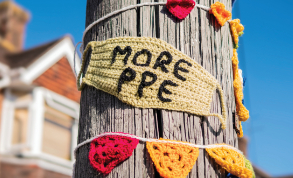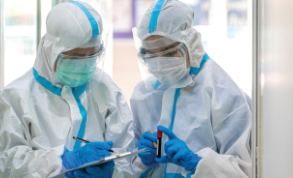Feature / Covid lessons learnt
It’s rare that NHS procurement is a top story in the national news, but the early months of the Covid pandemic brought story after story of personal protective equipment (PPE) shortages and desperate searches for enough PPE that was quality-assured and offered high levels of protection from the virus. As the national procurement body for the health service, NHS Supply Chain in particular was in the spotlight.
The procurement body was in danger of being overwhelmed, such was the demand for PPE, so a centrally run PPE procurement function was established to allow Supply Chain to focus on all other medical devices and clinical consumables.
This parallel or dedicated supply chain – a partnership that included NHS Supply Chain, the Department of Health and Social Care, the Ministry of Defence, and Clipper Logistics – helped turn around the supply of PPE stocks. It is supported by Supply Chain’s PPE buying teams, which are seconded to the government-led unit.
Colin McCready, NHS Supply Chain acting chief executive and chief financial officer, describes the first months of the pandemic in the spring of 2020 as ‘incredibly difficult’.
‘The reality is that the pandemic planning we had in place was for influenza. Due to the outbreak of Covid-19, demand went through the roof quickly, and required the government to widen the client base from around 200 trusts to 58,000 different settings. At the same time, all the world was demanding the same products largely from the same manufacturers, based in China.
‘We did everything we could to get as much in as soon as possible, and to make sure it was distributed as fairly as possible. But we needed something different because of the demand and complexity – and to make sure Supply Chain’s core services continued. It needed central control in the early days. We didn’t have full inventory visibility of which trust had what.’
Non-Covid supplies
Supply Chain also faced pressure around non-Covid supplies, with staff seconded into PPE work, while some items became difficult to source as manufacturers repurposed their factories for PPE production.
However, Mr McCready (pictured) feels that, apart from a few weeks early on in the pandemic, delivery of non-Covid supplies remained high. Over the pandemic period it has distributed Covid-related goods to intensive care units, products to kit out the Nightingale hospitals, and supplies to support the vaccination programme.
He is frank when asked if he thinks NHS Supply Chain’s reputation has taken a hit, even if unfairly so. ‘Yes. I would have to say that even before the pandemic, we had some goodwill to win back with trusts. It was incredibly challenging on the front line; they wanted products and, in some cases, they didn’t feel they got it.
‘It was a fast-moving and complicated situation, with everyone trying their hardest to respond to an unprecedented situation. I’m not making excuses – we didn’t get everything right, given the size and scale of the pandemic. We have learnt a lot of lessons that we are looking at incorporating into a sustainable model going forward.’
It is hoped that the worst of the pandemic is over, and NHS Supply Chain is looking to the future. A new substantive chief executive is due to be appointed over the summer, and it is working on bringing PPE procurement back into Supply Chain by 1 October. It will run a PPE procurement framework that allows the purchase of up to £5bn of PPE later this year to cover the winter and protect the NHS during potential further Covid waves if needed.
However, the parallel supply chain will continue until the end of 2021/22 to ensure that health and social care providers are not left exposed by a future rise in cases, and to enable moves to a more sustainable future model.
NHS Supply Chain is prepared for demand to return to pre-Covid levels and possibly higher as the NHS works to accelerate its elective recovery work. The rapid adoption of technology during the pandemic showed the possibilities open to the NHS, and Mr McCready says Supply Chain will be working to help trusts bring these advances into the service.
A number of lessons have been learnt from Covid, and will inform changes in pandemic planning across government and the NHS, Mr McCready says. Social care must be supported to the same level as healthcare, and greater understanding of supplies available in each health and care setting, together with the ability to scale up quickly, are vital to ensuring the right products get to the right places on time.
Also, he believes the power of central purchasing for pandemic supplies has been ably demonstrated.
Value-based procurement
Value-based procurement (VBP) is one project central to Supply Chain’s future plans. VBP takes a more holistic approach to procurement. Where traditional procurement focuses on reducing product costs, VBP shifts the emphasis to working alongside manufacturers to harness technologies that can improve outcomes for patients and reduce costs across the whole patient pathway.
A Supply Chain pilot study found that VBP can reduce waste and the number of products used; patients previously treated as inpatients can be treated as day cases; infections can fall; and operational productivity rise. ‘I think it’s clear that it’s a really big opportunity for the wider healthcare system, and something we want to actively encourage and support,’ Mr McCready says.
Traditional procurement – getting the best product for the lowest price – will remain a key part of the NHS armoury, but it must be enhanced to maintain savings or find ways to avoid costs. ‘We need to go after procurement savings – that’s always going to be important to get the best value for money. But, given where we are, these opportunities of volume aggregation are going to be diminishing.
‘Value-based procurement is different as it allows you to link to the outcomes and look beyond how much it costs. You might pay more, but the patient gets a better outcome or has a shorter stay in hospital. It looks after both prices and outcomes rather than just pennies off the pound, while also building capacity into the system.’
VBP could support the NHS elective recovery programmes. ‘It’s going to take a lot of effort to bring waiting times down. We are supporting the system by working closely with suppliers to deliver better outcomes, not necessarily the cheapest product, with the patient spending less time in hospital.’
While a switch to VBP might sound straightforward, he is under no illusions about how difficult this will be, especially as it would involve a rethink of traditional cost improvement programme measures and an aligned national system view on how to recognise the benefits.
‘This is easy to say, but hard to do. The system is currently set up to deliver in-year savings – that’s why we have an important role, asking if the NHS should be measuring value in a different way than it has historically. That requires central support to ensure trusts are incentivised in a different way and over the longer term.’
There are also practical hurdles to overcome. ‘Some of the benefits of VBP are hard to quantify and we are working with trusts and suppliers to think about how you quantify and measure the benefits, how KPIs could be written and reported back to the centre when the value is across a whole pathway.’
Mr McCready accepts there is a lot of work to get to this point, but insists it is a huge opportunity for NHS Supply Chain, suppliers and trusts, working together. ‘If we have learnt anything from the pandemic, it’s that if the NHS pulls together and breaks down barriers, what can be achieved is amazing. The vaccine programme is testament to that.
‘We are really excited about VBP. It’s hugely important for us and it is something we need to help drive forward with NHS England and NHS Improvement support to develop new metrics and incentivise it.’
As well as having discussions with the centre about efficiency metrics, Supply Chain must persuade suppliers to invest in new technologies and to support the measurement of their benefits.
‘Having a close working relationship with suppliers as a central procurement body means we can give them more comfort to take these risks. The NHS has been capital constrained for a long time, so it has to be win-win for both,’ says Mr McCready.
Trusts’ relationships with suppliers vary, he says, which helps explain why there can be so much variability in the prices paid for similar products. ‘As a centralised function, we can build relationships. If something works well, we can roll it out nationally.’
He acknowledges there is a risk of getting too close to one supplier. ‘It has to be a competitive market and we must make sure there is tension between different suppliers. However, we have to be able to work closely enough for them to feel it’s a partnership and they can benefit financially. You have to walk a fine line, and close relationships don’t exclude other suppliers, specifically SMEs.’
Support for the sustainability agenda also comes under the umbrella of VBP, and green measures such as re-manufacturing products could produce that win-win for suppliers and trusts. ‘It’s a big opportunity because it supports sustainability at a reduced cost,’ Mr McCready says.
But isn’t VBP just good practice? ‘On paper, it is what all procurement professionals should be doing, but it’s easy to say and difficult in practice. Everybody is incentivised to deliver against specific targets, which are based around costs. All procurement professionals would want to do more, but it is difficult in the current environment when targets are around savings. But the momentum for VBP is growing.’
Performance targets
Supply Chain still has a headline savings target of £2.4bn by the end of 2022/23 and to achieve an 80% market share (when Supply Chain was in partnership with DHL, before being brought totally under the Department of Health and Social Care in 2019, its share of the market was 40%). Covid has, of course, hampered its efforts to make savings on behalf of the NHS.
Demand for products not related to Covid-19 care declined last year, but not by as much as expected at the beginning of 2020/21, falling by just over 10%, he says.
‘Quantifying the effect on the core business may be difficult as how many opportunities for savings were trusts not able to take advantage of, because they were quite rightly focused on the pandemic. They didn’t want to be talking to us about savings.
‘In terms of market share, we have slightly over 60%, albeit on a slightly reduced overall market size and excluding PPE.’
He adds that the gain in market share was partly the result of the difficulties faced by some suppliers in sourcing products, which led trusts to turn to Supply Chain.
Mr McCready insists VBP represents an opportunity to make ‘some very large savings, as long as there is clarity and understanding of a national methodology for measuring it. This will allow us the ability to look beyond in-year savings to long-term savings’.
Supply Chain has reflected on the way it calculates the financial benefit of its work. ‘We have recognised that the methodology we use to measure savings is not the methodology used by trusts. So, we are now doing dual running, and are also tracking customer-based savings.’
For products offered via the Supply Chain category towers, savings are calculated using the prices in place at the start of service providers’ contract compared with the current price. For most, the baseline date is May-July 2018.
For trust-based savings, Supply Chain uses the price of the product one year before a purchase as the baseline.
For most transactions, cost price equals sale price, but prices customers pay vary – for example, due to multi-buy arrangements. Supply Chain says that while it is more relevant to trusts to measure savings on the price they pay – sell price – it is more accurate to measure tower procurement activity on the cost price before any margin/discount to customers. Savings in 2021/22 will be measured on the trust methodology.
Mr McCready continues: ‘It has been a challenging year for everybody, particularly our customers, and – quite rightly – they were not focused on savings during the height of the pandemic.
‘But we have still managed to deliver savings to trusts of just under £65m for the year, excluding what we deliver to NHS England and NHS Improvement for the High-Cost Tariff Excluded Devices programme.’ Overall, Supply Chain has been able to save the NHS £250m in the last financial year (calculated using NHS Supply Chain’s trust savings methodology).
He says this is one of the areas where Supply Chain hopes to build back the goodwill of trusts. ‘When we first launched, many trusts didn’t recognise the savings and it took away some of the credibility. We have worked hard to create a system to measure savings that trusts understand and we have been working closely with some trusts to ensure it’s what they want.’
Supply Chain will also highlight its broader benefits to the NHS. ‘We probably undersold ourselves in the early days a bit by focusing on savings that were not recognised by some of the trusts. But they are also paying for quality assurance, delivery free of charge, and invoicing, all delivered through our central funding.
‘We want to be more open on costs and value, listen to our customers and adapt to make sure we are giving them what they want. This will be a key part of our business plan for the next year. Customers will be a part of everything. Our priorities have changed – it’s not just about savings, but resilience and system support. Our mission is to be efficient, safe, sustainable, and resilient.’
The advent of system working is a positive development for Supply Chain, Mr McCready says, and he wants the organisation to work closely with ICSs. ’You get incentives of scale and it’s easier to roll out best practice and ensure everybody has the same level of service and savings. It will change the way we work, and we are working hard to make good relationships with the ICSs. For us, it’s a chance to have deeper strategic relationships across an entire regional market and become more efficient.
‘It has been a difficult year, but we are proud of the part we’ve played in supporting the incredible national effort. We know how challenging it has been for our trusts and we are supporting them. Things aren’t going to get back to normal any time soon, but I am excited about the coming year. It’s a turning point for the business, as we help to make a real difference for the NHS.’
The Covid pandemic clearly affected Supply Chain, as it has all other parts of the health service, but as the NHS returns to something like pre-Covid normality, it now sees its role differently.
Related content
The value masterclass shares examples of organisations and systems that have pursued a value-driven approach and the results they have achieved.
We are excited to bring you a fun packed Eastern Branch Conference in 2025 over three days.